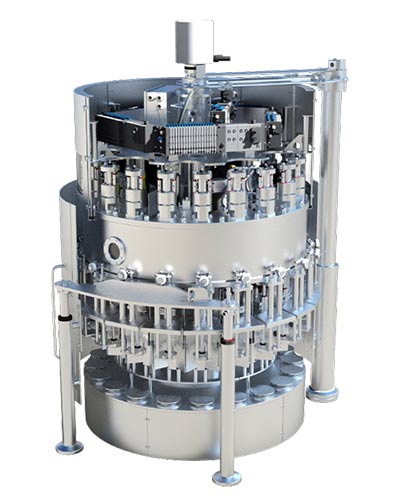FILLING WITH ELECTROPNEUMATIC VALVE

Electropneumatic fillers are extremely robust, complete and easy to clean. The wine is fed centrally from below to ensure no oxidation, and above all the tank is completely emptied. The tank is annular for each model and is completely machine-tool worked with a mirror-finished interior and conical bottom to facilitate cleaning and emptying. The cover is also machine-tool worked with a mirror-polished interior; mechanical fastening of the cover guarantees a perfect seal. Analog probes regulate the level in the tank and control both the in-feed solenoid valve and a feed pump with inverter if necessary. The height of the filler is adjusted electrically by PLC. The centralized level adjustment is performed electrically and automatically. Activation or deactivation of dummy bottles are performed automatically. The bottle-raising pedestals are pneumatic with cam return and automatic lubrication. The filler is completely arranged for a sterilization CIP circuit.
All models can be in HP version for bottling of sparkling liquids with a working pressure between 0 and 8 bars or in LP version for still liquids or slightly sparkling with a working pressure from 0 to 2 bars.
ADVANTAGES
- FLEXIBLE FILLING – All the operating parameters: vacuum in bottle, working pressure (from 0 to 8 bar) partial opening, filling level and degassing cycle are set on the control panel and can be modified without any manual intervention. Therefore, it will be possible to pass from one type of bottling to another easily. The liquid passage opening can be divided to have a large flow filling followed by a reduced flow. This is an advantageous solution for difficult products because the foam is limited and the level is precise.
- LEVEL ADJUSTMENT – Automatic and centralized level adjustment with an adjustment range from 25 to 100mm from the rim, even with the machine running. The shape of the valves enables it to reach a specific level with a tolerance of ± 1 mm, due to the levelling operation.
- STRUCTURE WITH DOUBLE TUBE WITH LOWER CLOSING – The closure of the filling and the gas return tubes enables them to reach precise levels even without using the levelling procedure. However, it is recommended to use the levelling device, as it considerably reduces the product quantity into the gas return tube, which benefits the next bottling operation. To be sure of the gas return for this minimum quantity of product, it is advisable to choose the solution E2 with the gas return in a separate vessel. The closure of the gas return tube has many advantages during the degassing phase with an important increase in productivity of sparkling wines.
- AUTOMATIC DUMMY BOTTLE – Automatic and simultaneous positioning of all dummy bottles, always present on the machine. The GAI dummy bottle is under patent protection and is able to optimize sterilization because it is possible to open or close the discharge according to the specific circuit that needs cleaning.
- SECURITY OF STERILIZATION CYCLE – Electro-pneumatic valves, together with dummy bottles with discharge circuit, guarantee effective and well defined sterilizing cycles for each filler circuit. The automatic CIP is strongly recommended for time-saving and for sterilization cycle security.
- OPERATING CYCLE ITERATION – The filling cycle, managed with timing phases, guarantee the maximum iteration, making it unaffected to speed variation on the production line. Working phases can be optimized and personalized according to the product to be bottled, improving quality and productivity. Timing is determined in seconds, tenths and hundredths with a repeatability of 1/100 of second.
- BOTTLE DETECTION – The proximity of each spout guarantees the bottle real presence and enables it to start the filling cycle exactly when the bottle is sealed on the cone.
- PRESSURE TRANSDUCER – The pressure transducer on each spout enables it to constantly control the bottle pressure, in order to check that the filling cycle is carried out correctly and to detect any anomalies or malfunctions. These controls allow for the detection of insufficient vacuum, exploded bottles or missing seals on the cone, pressure trends during degassing and the efficiency of every single filling valve.
- STRUCTURE WITH FOUR ELECTROPNEUMATIC VALVES – Using four electropneumatic valves to separately control the following circuits:
- vacuum
- tank gas
- levelling
- degassing.
In comparison with the systems with three valves only, the tank gas valve enables pressure compensation in the bottle without using the return gas tube (it avoids sprinkling product residues inside the bottle). The electropneumatic valves and the in-feed pipes placed near the filling spouts minimize the volume in the pipe, thus reducing gas consumption, increasing productivity and ensuring an easy and proper filler sterilization.
10. FORMAT SAVING
The filling cycle can be set through the control panel and it does not require any manual intervention on the filler. Saving cycles and repeating them simplifies and speeds up the format change operation, ensuring more uniformity in the process.
LIGHT PRESSURE VALVE: LP
LP valve is exactly the same as HP version, except from the degassing circuit. This valve was designed to bottle still or slightly sparkling products with a working pressure from 0 to 2 bars. Thanks to this relatively low pressure, the degassing operation is not necessary because it occurs spontaneously when the bottle is moved away from the filling valve. The valve and the filler configurations are simpler and therefore cheaper, but with the same operations of bottle vacuum, tank gas and levelling. Therefore, LP version has all advantages described for E HP, but cannot bottle sparkling wines or be modified to do this. E HP can bottle both still and sparkling products; E LP can bottle only still or slightly sparkling products.

